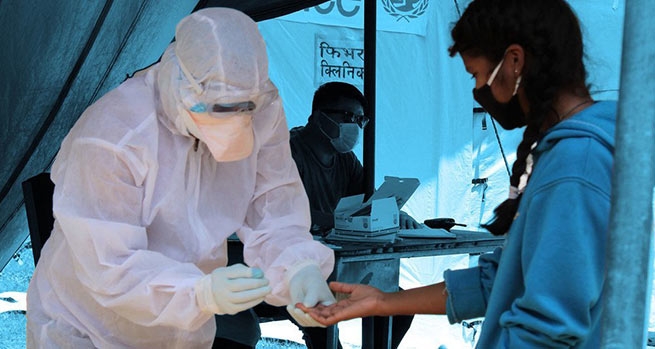Apparently, the leadership of the WHO and the apologists for “global warming” finally “melted”, and in connection with this, a new scheme was developed to fool and rob humanity under the general name “Climate crisis – the cause of a new pandemic.”
“Climate change will kill people because it encourages the emergence and spread of infectious diseases,” Peter Sands, executive director of the Global Fund to Fight AIDS, Tuberculosis and Malaria, warned a few months ago.
Sands’s statement, while some may call it harsh, is by no means hypothetical, as numerous studies, especially since the lifting of restrictive measures against Covid-19, do not doubt that the next health crisis may be the impact of climate change, fueling existing and non-existent diseases. , believes Sophia Christouauthor of the publication “Kathimerini”.
Seeing that environmental changes are now happening much faster than in the past, experts are concerned that this crisis is increasing the possibility of the spread of pathogens and viruses to which no human is immune.
223 diseases exacerbated due to climate change
According to a study published in the journal Nature, 223 human pathogens have escalated due to a wide range of climate risks caused by ongoing greenhouse gas emissions and other factors. In fact, experts note that the sheer number of pathogenic diseases exacerbated by climate risks indicates the magnitude of the threat to human health caused by climate change and the urgent need for aggressive action to overcome the climate crisis.
However, it appears that the effects of climate change are already having a marked impact on the health of people in different parts of the world. For example, in Abakaliki, in southeast Nigeria, the effects of the climate crisis have led to an increase in the number of rats in the area. As a result, people often get Lassa hemorrhagic fever, for which there is no vaccine yet.
A billion people are exposed to “disease vectors”
But not only Lassa hemorrhagic fever worries scientists. Global warming could cause the main vectors of the disease, namely the tiger mosquito (Aedes Aegypti) and the Asian tiger mosquito (Aedes Albopictus), to spread hundreds of kilometers from where they now occur.
According to a related study published in 2019, in the next century, about a billion people may experience transmission of the virus from any mosquito for the first time in Europe and in tropical and subtropical highlands.
“Disease X”
These are not the only worrying facts that are at the center of the attention of the scientific community, as climate change further increases the risk of a new infectious disease (known as “disease X”), which can be transmitted from animals and cause a new wave of pandemic. Disease X, this as yet unknown virus, is already a threat to the future and is on the World Health Organization’s pandemic risk list. The climate crisis is the back door to a new pandemic.
Ames Adaya, an American infectious disease physician and senior fellow in infectious disease and bioterrorism at the Johns Hopkins Center for Health Security, explains to K how the climate crisis is fueling the growth of some pathogens in particular and the spread of infections in general.
Changes in rainfall, temperature and extreme weather events could contribute to human exposure to new pathogens, which may even be unprecedented in a particular geographic area, he said. “People are forced to adapt to climatic conditions, which increases the chances of coming close to certain pathogens – for example, by moving to certain areas or staying more indoors, or using more air conditioners (legionnaires’ disease),” says Dr. Adaya.
However, as people move to areas more saturated with pathogens – for example, due to the presence of various animal species – the risk of new infections (“disease X”) increases, according to the scientist.
Hans Kluge in “K”: “EU must invest in better surveillance systems”
Speaking to K, WHO Regional Director for Europe Dr. Hans Kluge noted that rapid climate change does pose a number of risks to our health and therefore the international community must be prepared.
According to Dr. Kluge, biodiversity loss, intensive farming practices and human encroachment on wildlife habitats can significantly increase the risk of animal-to-human transmission of viruses. At the same time, about 70% of emerging diseases – Ebola, Zika, Nipah encephalitis – and almost all known pandemics – influenza, HIV / AIDS, COVID-19 – are zoonoses, that is, diseases caused by microbes of animal origin.
The WHO Regional Director for Europe believes that the solution to the problem is twofold. “First, we urgently need to overcome the climate crisis by moving away from fossil fuels, investing in renewable energy, maintaining biodiversity and planetary health. Secondly, countries need to adapt to climate change, including by making their health systems more resilient and improve their ability to cope with future pandemics.”
Dr. Kluge believes that to do this, EU Member States need to invest in improving surveillance systems for infectious diseases and other health threats, as well as develop and implement national health adaptation plans, making climate resilience, low-carbon service delivery and environmental sustainability integral components of the NHS .
Valuable lessons from the covid-19 pandemic
At the same time, Kluge notes that there are valuable lessons that governments should learn from the Covid-19 pandemic. “We must focus our efforts on learning the lessons from this pandemic. The goal for both Greece and other European countries should be to strengthen human resources in the health sector and better engage communities to ensure health equity. For this reason, the desire for a common pan-European approach to public health and improving communication on science and health issues remain two critical issues for discussion,” concludes Dr Kluge.







More Stories
Today the world remembers the accident at the Chernobyl nuclear power plant
A trial has begun in the case of a fatal accident involving Dora Bakoyanni's car.
Poll: which European countries are ready to defend their homeland to the last